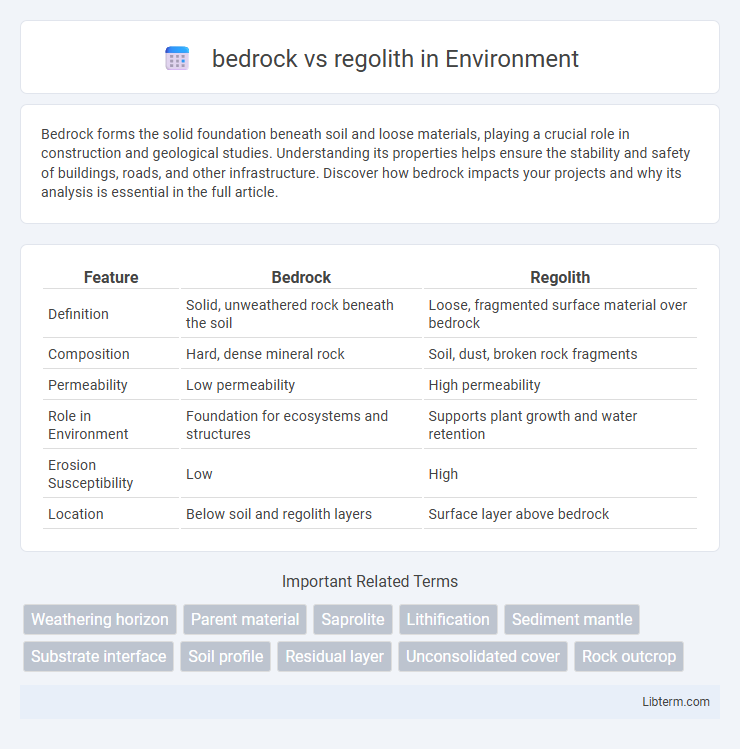Bedrock forms the solid foundation beneath soil and loose materials, playing a crucial role in construction and geological studies. Understanding its properties helps ensure the stability and safety of buildings, roads, and other infrastructure. Discover how bedrock impacts your projects and why its analysis is essential in the full article.
Table of Comparison
| Feature | Bedrock | Regolith |
|---|---|---|
| Definition | Solid, unweathered rock beneath the soil | Loose, fragmented surface material over bedrock |
| Composition | Hard, dense mineral rock | Soil, dust, broken rock fragments |
| Permeability | Low permeability | High permeability |
| Role in Environment | Foundation for ecosystems and structures | Supports plant growth and water retention |
| Erosion Susceptibility | Low | High |
| Location | Below soil and regolith layers | Surface layer above bedrock |
Understanding Bedrock: Definition and Characteristics
Bedrock is the solid, unweathered rock layer that lies beneath soil, regolith, and other surface materials, providing foundational stability for landscapes and human structures. Characterized by its hardness and resistance to erosion, bedrock forms the geological base that influences topography, groundwater flow, and mineral resource distribution. Unlike regolith, which consists of loose, fragmented material, bedrock remains largely intact and unaltered by surface weathering processes.
What is Regolith? Composition and Features
Regolith is a layer of loose, heterogeneous material covering solid bedrock, composed mainly of dust, soil, broken rock, and other related materials. Its features include varied particle sizes, from fine dust to larger rock fragments, and composition influenced by local geological processes, weathering, and biological activity. Regolith plays a crucial role in soil formation, water retention, and providing nutrients to ecosystems.
Formation Processes: Bedrock vs Regolith
Bedrock forms through solidification and crystallization of magma or the lithification of sediment, creating a dense and coherent geological layer beneath the Earth's surface. Regolith develops from the physical and chemical weathering of bedrock, resulting in a loose, heterogeneous layer composed of soil, rock fragments, and organic matter. The transformation from bedrock to regolith involves processes such as freeze-thaw cycles, oxidation, and biological activity, which break down the solid rock into smaller particles.
Key Differences Between Bedrock and Regolith
Bedrock is the solid, unweathered rock layer beneath the soil, providing a stable foundation for geological formations, while regolith consists of loose, fragmented materials like soil, sand, and gravel formed from the weathering of bedrock. Bedrock exhibits low porosity and high density, making it impermeable to water, whereas regolith has higher porosity and permeability, facilitating water infiltration and root growth. The primary distinction lies in bedrock's intact geological structure compared to the unconsolidated, heterogeneous composition of regolith.
Geologic Significance of Bedrock
Bedrock serves as the unweathered, solid foundation beneath soil and regolith, providing critical information about the Earth's geologic history and structural composition. Its study reveals insights into tectonic processes, mineral composition, and the formation of natural resources, distinguishing it from the loose, weathered materials of the regolith. Understanding bedrock is essential for applications such as earthquake analysis, groundwater flow assessment, and construction stability.
Environmental Importance of Regolith
Regolith plays a crucial role in environmental sustainability by supporting soil formation, nutrient cycling, and water filtration essential for plant growth and ecosystem health. Unlike bedrock, regolith acts as a dynamic interface between the atmosphere and the Earth's crust, facilitating carbon sequestration and mitigating erosion. Its porous nature enhances groundwater recharge and maintains soil moisture balance, making it vital for maintaining terrestrial habitats and agricultural productivity.
Role in Soil Formation and Ecosystems
Bedrock serves as the primary parent material from which regolith, a layer of loose, heterogeneous material, is derived through weathering processes, providing essential minerals for soil formation. Regolith acts as the foundational substrate that supports root penetration, water retention, and microbial activity, directly influencing soil fertility and ecosystem productivity. The transition from bedrock to regolith is critical in developing soil horizons, which sustain diverse plant communities and regulate nutrient cycling within terrestrial ecosystems.
Bedrock and Regolith in Engineering and Construction
Bedrock provides a stable, solid foundation essential for supporting heavy structures and ensuring long-term stability in engineering and construction projects. Regolith, composed of loose, unconsolidated materials such as soil, sand, and gravel, often requires compaction or removal before building to prevent settlement and structural failure. Understanding the properties and depth of bedrock versus regolith is critical for foundation design, excavation planning, and assessing load-bearing capacity in civil engineering applications.
Occurrence on Earth and Other Planets
Bedrock, the solid rock layer beneath the soil, commonly occurs on Earth and forms the foundation of continental and oceanic crusts, while regolith consists of loose, fragmented materials covering the bedrock, including soil, dust, and broken rock fragments. On Earth, regolith covers most bedrock surfaces, shaped by weathering processes, erosion, and biological activity, whereas on the Moon and Mars, regolith is primarily formed by meteoroid impacts and lacks organic components. The presence and composition of bedrock and regolith vary significantly across planetary bodies due to differences in geological activity, atmospheric conditions, and impact history.
Summary Table: Bedrock vs Regolith at a Glance
Bedrock is solid, unweathered rock forming the Earth's crust, while regolith consists of loose, fragmented materials like soil, sand, and gravel overlaying bedrock. Bedrock typically has high density and low porosity, providing structural support, whereas regolith exhibits lower density and higher porosity, influencing water retention and root penetration. Key distinctions include bedrock's role as a stable geological foundation and regolith's importance in ecosystems and surface processes.
bedrock Infographic

 libterm.com
libterm.com